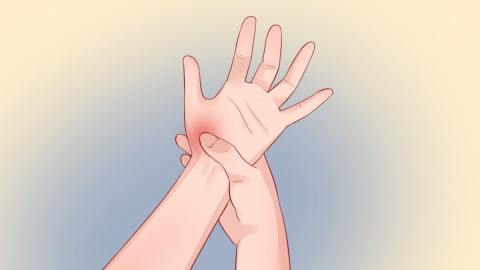What causes a painful sensation like a strained tendon in the right arm?
Under normal circumstances, pain in a single tendon-like structure in the right arm may be caused by muscle strain, poor posture, tendonitis, cervical spondylosis, or periarthritis of the shoulder. It is recommended to seek medical attention promptly, identify the underlying cause, and receive symptomatic treatment under a doctor's guidance. Specific analyses are as follows:

1. Muscle strain: Often caused by overuse of the arm, such as prolonged heavy lifting or frequent physical activity, leading to muscle tension that pulls on surrounding tissues and causes pain. Resting and reducing arm movement, combined with local heat application to promote blood circulation, can help relieve pain.
2. Poor posture: Maintaining head-down positions for long periods, working at a desk, or compressing the arm while lying on one's side can keep arm muscles and fascia in a tense state, resulting in pain. Daily postures should be corrected, and regular arm movements and stretching exercises during work breaks can help relax the muscles.
3. Tendonitis: Usually caused by repeated friction or overuse of tendons, commonly seen in individuals who frequently use their arms. Pain is typically localized at the site where the tendon attaches. Patients may follow medical advice to take medications such as ibuprofen sustained-release capsules, diclofenac sodium enteric-coated tablets, or celecoxib capsules to alleviate pain.
4. Cervical spondylosis: Herniated cervical discs or bone spurs may compress nerve roots, causing pain that radiates to the right arm, often accompanied by symptoms such as numbness and weakness. Patients may take medications such as mecobalamin tablets, vitamin B1 tablets, or Jingfukang granules as prescribed to nourish nerves and relieve symptoms.
5. Periarthritis of the shoulder: Inflammation of soft tissues around the shoulder joint leads to restricted shoulder movement, with pain radiating to the arm—especially worsening when raising the arm. Patients may take anti-inflammatory medications such as etoricoxib tablets, meloxicam tablets, or loxoprofen sodium tablets as directed by a physician. Shoulder joint release surgery may also be considered to improve joint mobility.
In daily life, it is important to avoid overworking the arms, control the weight when lifting objects, and avoid sudden exertion. Additionally, keeping the arms warm to prevent cold exposure—which could worsen pain—is advised. Appropriate stretching exercises can also strengthen muscle resilience.




